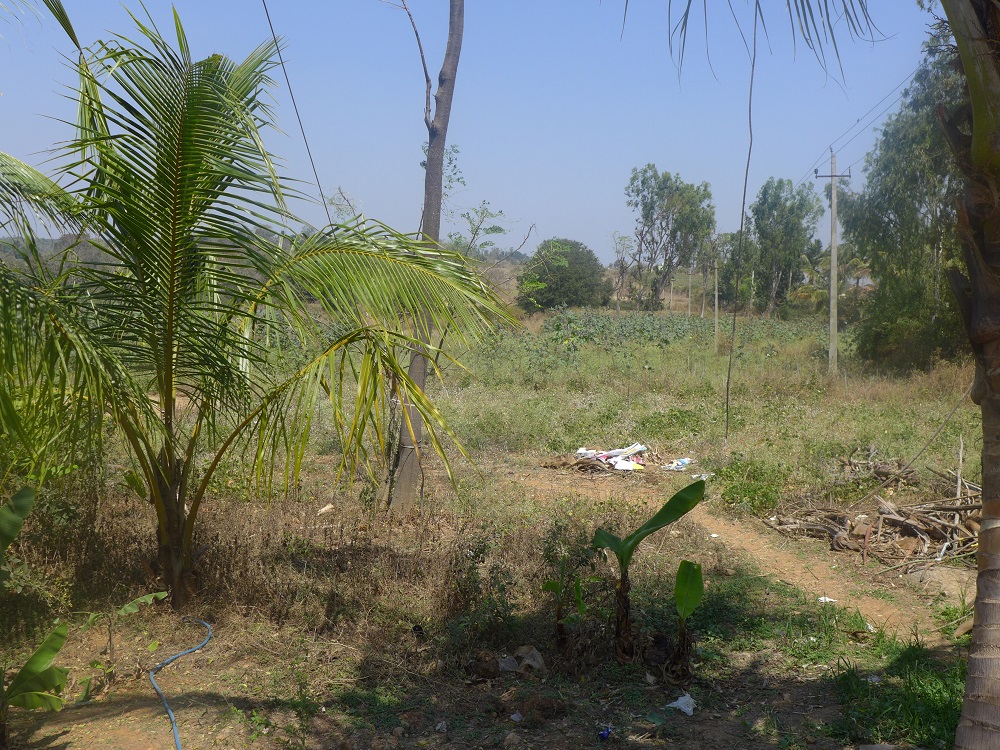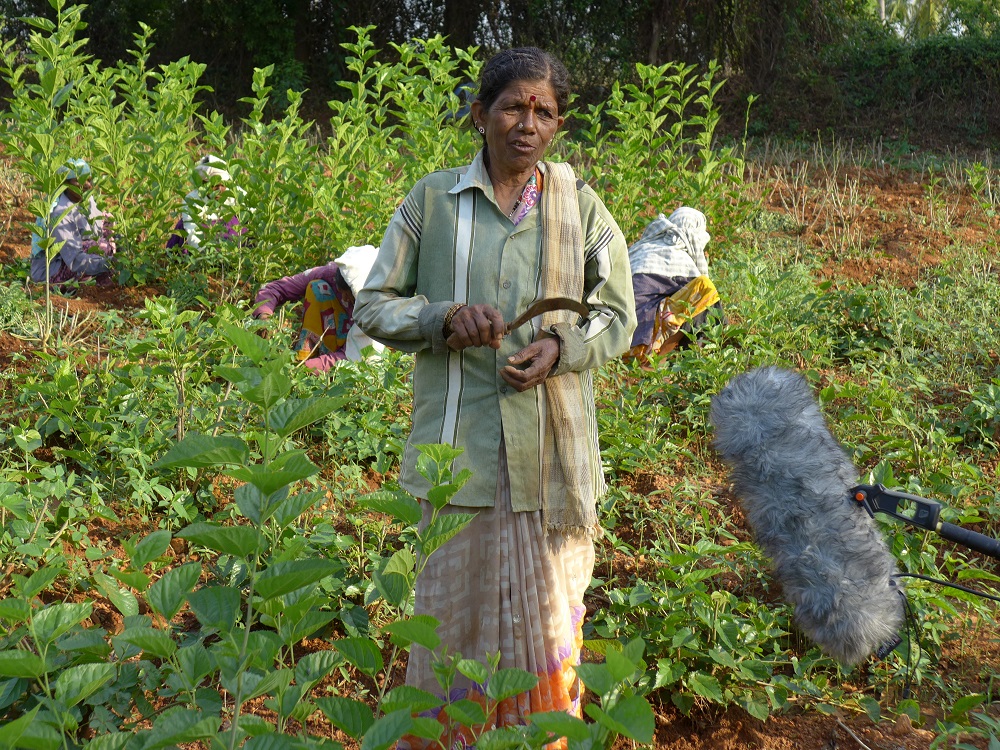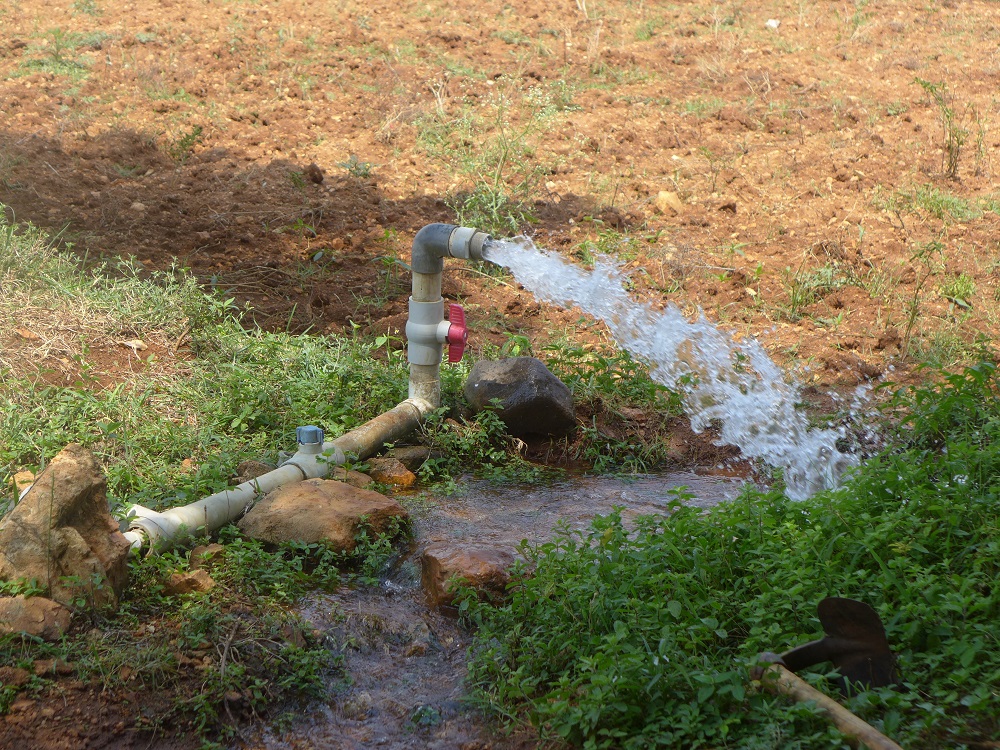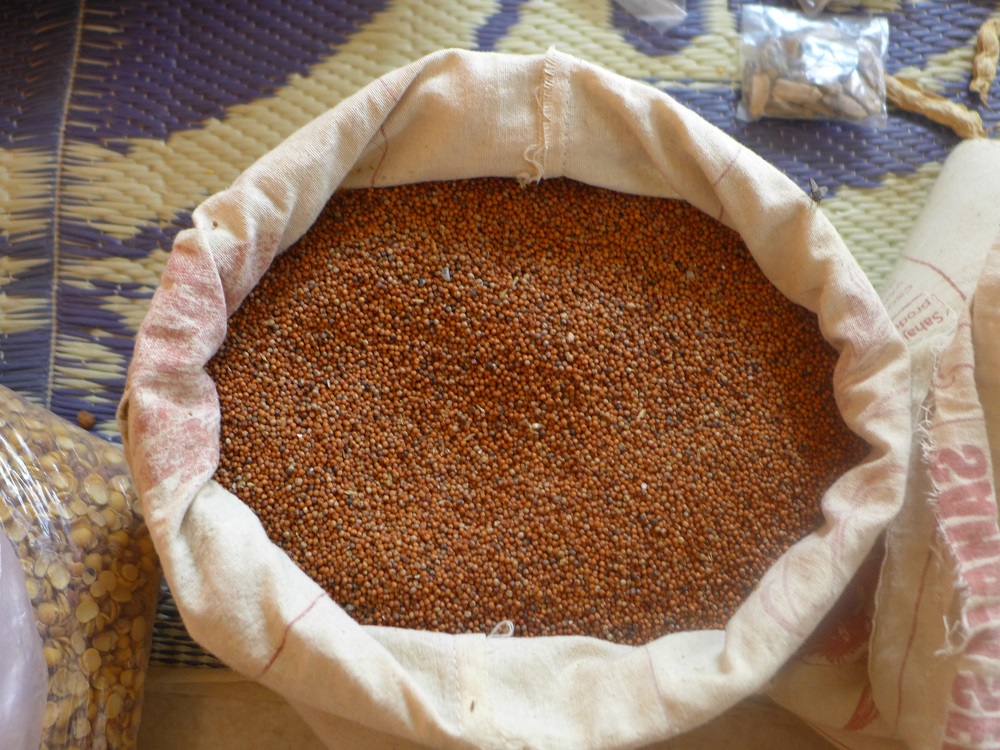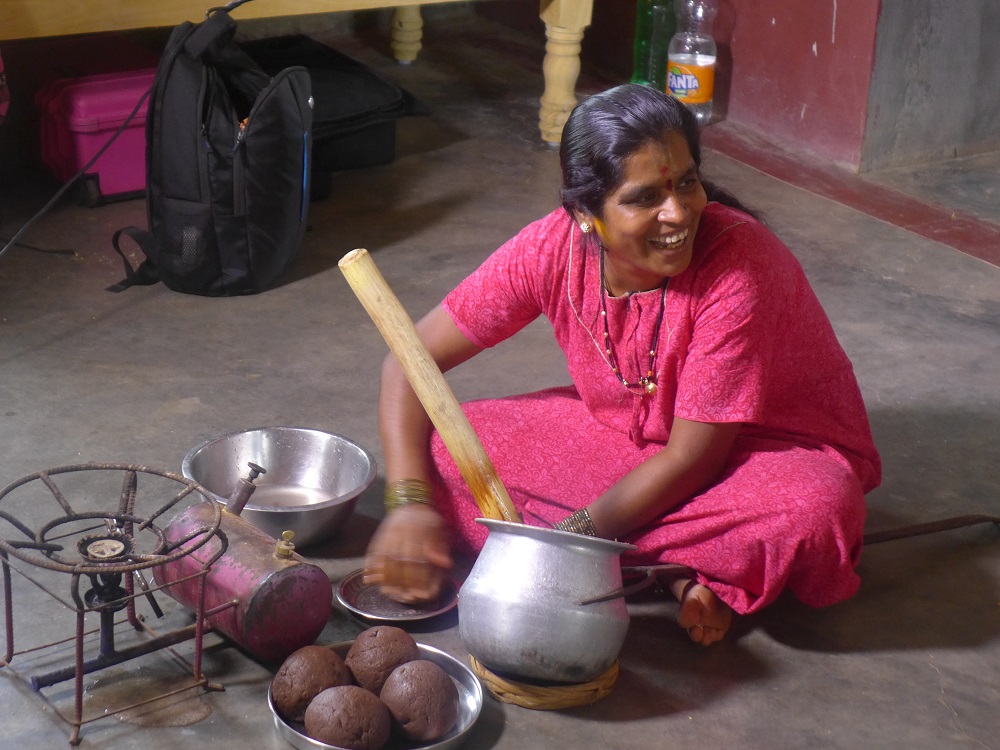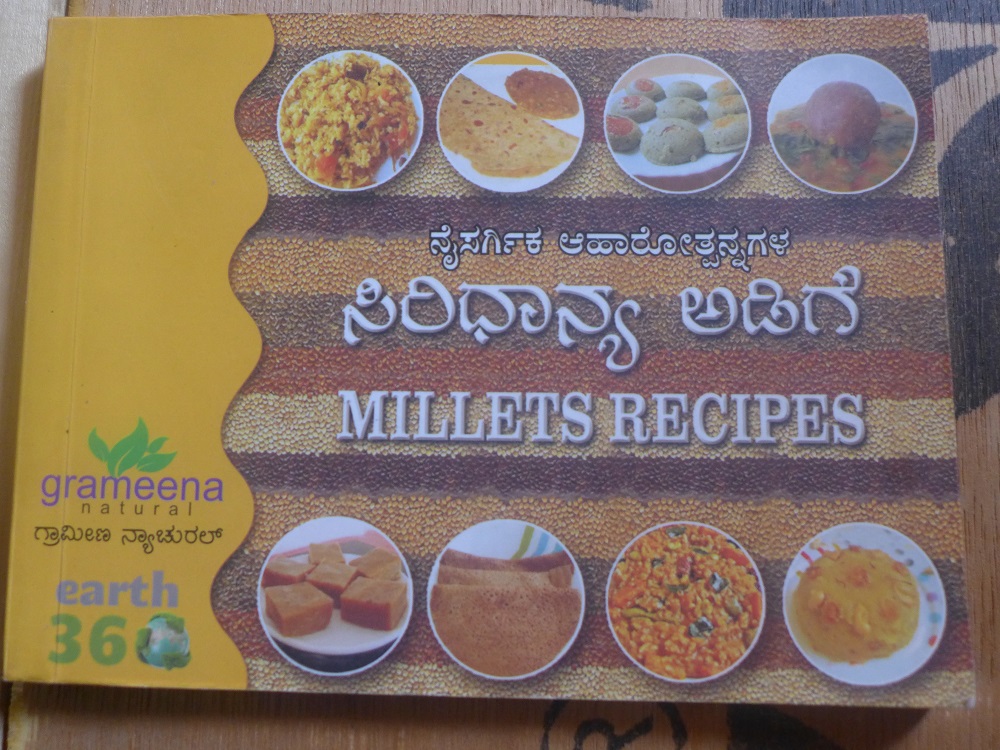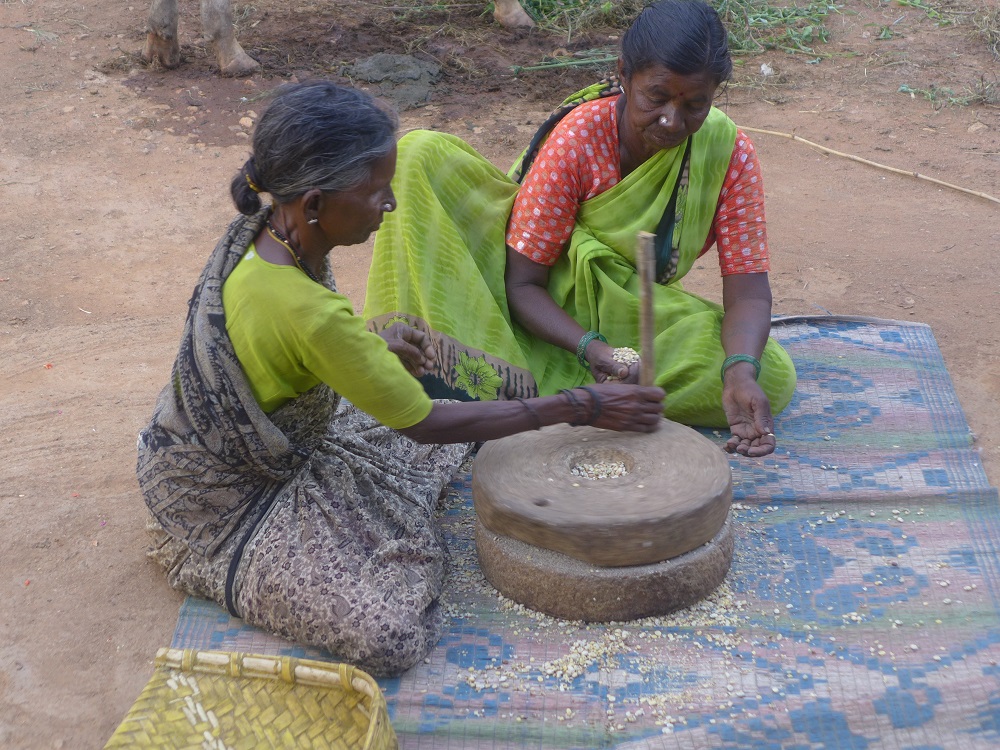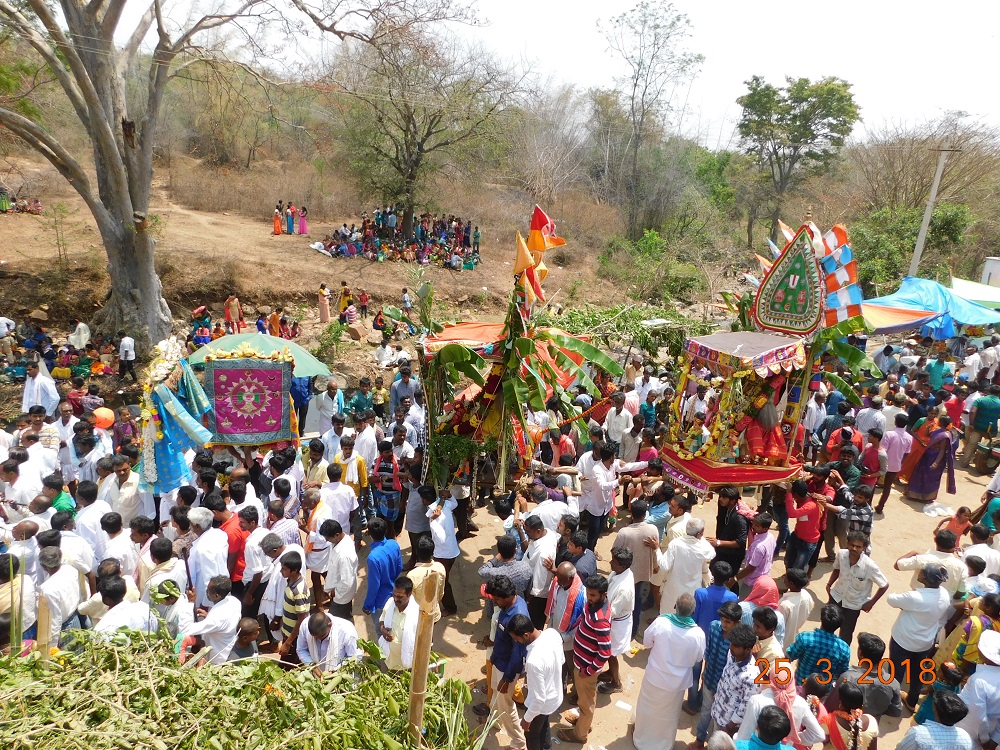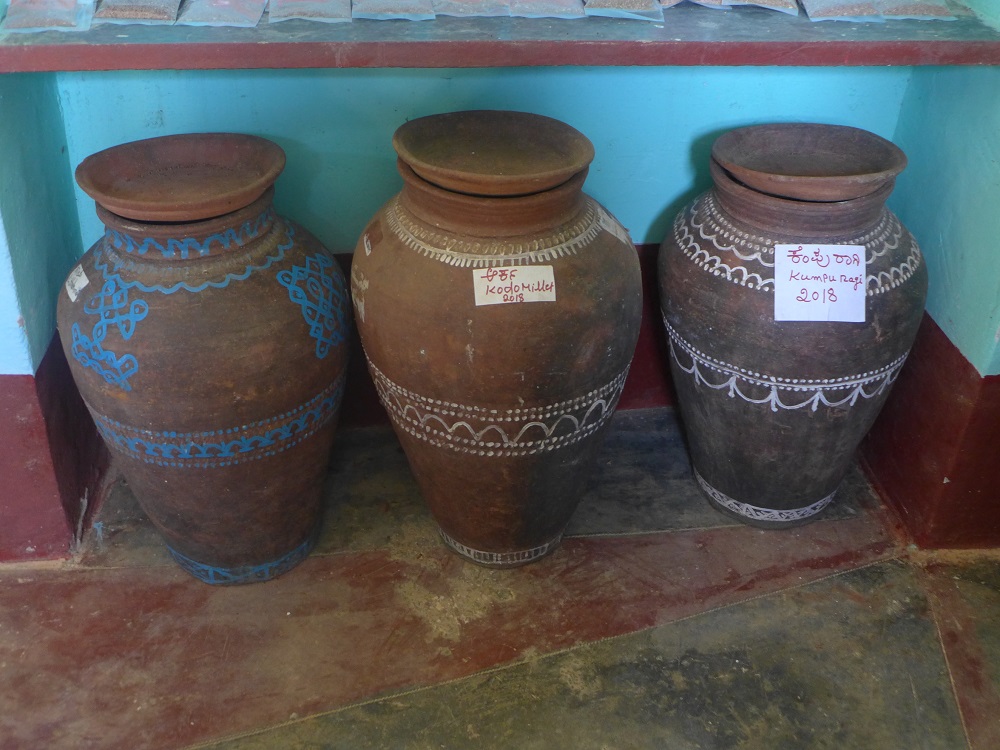Oral History
‘I remember when it used to rain well and we could trust the weather’. Women’s stories of changing farming lives in southern India.
By Sandip Hazareesingh, posted on 12 May 2020
Introduction
As an arts and humanities method, oral history is particularly conducive to reclaiming the voices and life experiences of subaltern groups such as women smallholders. These voices are generally not heard or marginalised in written historical and contemporary documentary records. Oral history interviewing is a cooperative and collaborative process between interviewer and narrator involving information-sharing, the recall of autobiographical memories, of happenings and feelings. As distinct from the standardised written form, orality offers varied narrative forms which may include reported speech, songs, reflections and social commentary which belong specifically to the cultural world of the narrators. Through these narratives, people tell stories to interpret and make sense of their life experiences (Abrams 2016).
The oral history project team conducted audio and filmed interviews with 17 women smallholders in several villages of Kanakapura taluka (sub-district) in Ramanagara district, Karnataka, between March and June 2018. The primary aim of the project was to document women farmers’ memories of changes in farming practices and in weather conditions that they had experienced in their lifetime. However, participants were encouraged to shape their narratives as much as they wished by talking about subjects, activities, and life episodes that they themselves regarded as significant and meaningful.
Experienced changes in weather
As it happened, most of the elderly farmers interviewed were keen to talk about the changes in weather they had experienced, particularly the increasing drought-prone conditions. Now in her seventies, Lakshmi Bai from Virayanadoddi village recalled that when she was growing up in the 1950s, ‘it used to rain well, we could trust the weather’: in those days summer lasted a full three months, it was usually mild with temperatures not exceeding 20-24 degrees, but these days they can reach 30-40 degrees, which is unbearable’ (Interview with Lakshmi Bai, 12 March 2018).
Shivamma from Allanatha village concurred, observing that when she was a child, ‘the weather was cooler, and I remember the hills and mountains being lush. Trees were not cut down, so the weather was good’ (Interview with Shivamma, 27 April 2018). Prema from Kokreshalli village also remembered that when she was young, about 40 years ago, the lakes, wells, and canals were full of water. But particularly since the turn of the century, the rains have been failing and they now have to draw water from bore wells. This has led to other problems as she explained:
Farming land is always at its best with plenty of natural rainfall for nurturing our crops; with water from bore wells we don’t quite get the same quality of yield. In those days we didn’t use chemical fertilizers or pesticides against insects as with the good rains, there was plenty of greenery and weeds for the insects to feed on. But as the soil has become drier, they go for whatever crops we’ve planted (Interview with Prema, 23 March 2018).
Moreover, not only was there now less rain from the south-west monsoon during the main sowing season, the rainfall itself had become more isolated, often occurring in one village but not in another even close by. The farmers suggested that one reason for the erratic rains was the considerable deforestation that has occurred in the region over the past fifty years. Eighty-five year-old Ramakka stood in the bright yellow sun gazing towards the distant horizon from her farm in Billedale village. ‘Fifty years ago this region was virtually all forest’, she observed. ‘There was just one road, the one you can see from here, which was much narrower back then, where bullock-carts used to be the only traffic’ (Interview with Ramakka, 6 March 2018).
Perhaps the loss of a sense of trust in weather patterns defines one of the crucial ways in which these farming communities experience, via personal memories, climate change on the ground. It is through their weather memories, and the experienced contrast between past and present, that farmers in Kanakapura have built up a sense of unpredictability and change about their local climate, enabling them to identify weather-related changes to familiar landscapes.
The past half-century has witnessed over 70% loss of trees, vegetation, and water bodies in the districts of Bangalore and Bangalore Rural immediately to the east of Ramanagara. At the same time, in Ramanagara district itself, the once thick forests are reported to have ‘almost vanished’ with the forests in its four talukas substantially cut down and lands distributed to farmers by government (GoI 2014).
Climatologists have pointed out that deforestation on such a scale reduces the land’s capacity to absorb the greenhouse gases resulting from human activities, thus contributing to a rise in land temperatures (IPCC 2019; Levin and Parsons 2019), as farmers seem to have experienced in Ramanagara; thick tropical forests are also conducive to abundant rainfall as trees draw water from the ground through their roots and then release water vapour through their foliage into the atmosphere, which results in cloud formation (Pearce 2018). Significantly, patterns of declining rainfall over southern India during the south-west monsoon have been found to match regional forest cover loss (Paul et al. 2018), and Ramanagara would seem to provide a local illustration of this process.
The changing weather’s impact on the agricultural season is clearly a major concern for the smallholders in Kanakapura. The combination of higher temperatures and decreased rainfall has resulted in a loss of soil moisture and a reduction in the period of crop growth. Shivamma believes that two of the early pre-monsoon rains known as revati male and ashwini male that usually occur in March and early April and upon which the sowing of her sesame crop traditionally depended, were no longer as reliable as they were twenty years ago. ‘So we now pay particular attention to the rainfall expected in late April and May, the showers we call bharani male’, Lakshmi Bai explained. ‘If these showers arrive, we can still feel confident about the rainfall for the main sowing season’ (Interview with Lakshmi Bai, 6 March 2018).
Even though Shivamma has noticed that in recent years the soil does not remain moist for long after these rains, this problem has partly been reduced by the tractor which they began using about fifteen years ago. While most small farmers continue to use the wooden plough alongside the tractor, the new machine, she explains, ‘has allowed us to work most of the land in a day. Before, when we were just using the plough, we tended like in our grandmothers’ time to wait for the rains to fall in chronological order, but now with the tractor we can plough the land and start sowing after any of the rains’.
This increase in resource endowment has helped her to adopt a climate adaptive strategy in relation to her main crop, ragi (finger millet), and she now grows the 3-month rather than the 5-month varieties that used to be predominantly cultivated twenty years ago, as the rainfall tends to be more reliable over the shorter period. ‘The Adri male rains (in June) give us the signal for the sowing of ragi and groundnut (another nitrogen-fixing crop) in a mixed cropping pattern’, she says, which increases their chances of survival’ (Interview with Shivamma, 5 April 2018).
Securing the annual ragi crop remains important for most smallholders, as risk minimising and resilience in the face of the threat of rainfall failure continues to take the customary form of stocking up with a sufficient supply of millets for both food and fodder for two or three years. Kalamma and her family in Bannali village maintain a longstanding tradition of holding a permanent reserve supply of 18 sacks of ragi, which is deemed sufficient for about two years. Similarly, Prema stocks finger millet produced from nati (local indigenous) varieties for household consumption and never for sale. Climate provoked food security concerns ensure that finger millets remain a significant aspect of smallholding families’ foodways in rural southern Karnataka, even if less dominant than they once were.
Changes in food consumption
Indeed, women’s narratives suggest that rice has largely replaced ragi as the first choice food in the villages over the past 30 years. Women recalled the pervasiveness of ragi in local diets during their childhood, mainly in the 1960s and 70s and earlier in some cases. ‘As children, we were given ragi mudde (finger millet soft balls) in the mornings and evenings, and rotis made out of ragi, eaten with curd, in-between; we never had rice, and even chapati is a very recent food. But now, no one eats ragi, rice has taken over’, Devaramma from Virayanadoddi village, proclaimed (Interview with Devaramma, 12 March 2018).
But as we probe her further and speak to more women, a more nuanced reality emerges: it becomes evident that ragi and rice co-exist side-by-side in virtually all households, with the main divide being essentially generational, though there also persists a cultural perception of ragi and millets as superior to rice in taste and nutritional qualities and as the essential staple for a healthy diet. Ragi, and the ragi mudde dish in particular, continues to be eaten, though mainly by the older generation of villagers over 60 years of age; the younger generation of women farmers, and their menfolk, prefer cooking and eating rice.
‘I myself enjoy the taste of ragi, but the daughters-in-law prefer rice which is quicker to make; preparing ragi mudde is physically demanding, it takes time and effort to achieve the required consistency’, Devaramma’s neighbour, Lakshmi Bai, explained (Interview with Lakshmi Bai, 6 March 2018). ‘These days men turn down mudde and ask instead for rice’, adds Ramakka, from Billedalle village (Interview with Ramakka, 4 April 2018). ‘Having rice is definitely a status symbol, a display of affluence, Devaramma affirmed. ‘It means not to be associated with the poor man’s food anymore’.
She went on to describe one of the ways in which the cultural taste for rice was popularized in her village, recounting a story from her childhood days about a rich local landowner who was attending the village panchayat (council) and had fixed a grain of rice on his moustache, pointing to it, and telling people just how tasty rice was. Given the prestige commanded locally by powerful landowners back then, such demonstrations would have been quite persuasive. But she identifies the Public Distribution System (PDS) as the decisive influence, as it had effectively brought rice into the homes of the majority of people in her village.
Set up in the 1970s by central government in the wake of the Green Revolution, the PDS aimed at ensuring food security at the household level throughout India. With a primary focus on staple grain access, it sought to make rice available at highly subsidized prices in all rural areas through a chain of local Fair Price Shops (FPS). However, the post-colonial State’s approach to tackling hunger and banishing the spectre of famine experienced by the rural poor during colonial rule was based on ensuring calorie sufficiency rather than a balanced, nutritious diet (Pingali et al. 2017; Landy 2017).
‘It became cheaper to buy rice than to grow ragi’, Devaramma observed. As a result, in her own family, they moved to cooking more rice than ragi dishes which was gradually reduced to one meal a day. The emergence of the hegemony of rice in rural smallholders’ foodways, at least at the level of consumption, seems to have been determined by a range of converging trajectories: symbolic aspirations for status uplift, for cultural ‘modernity’ created a receptive mood for the Indian State’s rice promotion campaigns based on field demonstrations and a series of brochures and films produced by the Ministry of Information and Broadcasting.
But this model of food security also represented a broader process of ideological persuasion as India’s rural poverty became a priority for intervention by the United States in the context of the Cold War. In essence, American aid and agricultural experts remade Indian agriculture in the 1960s on the basis of hybrid crops, chemical fertilizers, intensified irrigation, and credit, with ‘high yielding’ varieties of paddy at the heart of this new strategy (Siegel 2018).
Nonetheless, even if rice has gained an ascendency, most of the women feel that millet foods have been experiencing a revival in recent years. ‘We eat ragi mudde for breakfast and dinner, with different pulses and vegetables because we know it’s good for us’, Ramakka from Billedalle village declared. ‘If we feel hungry in-between, we cook some rice’. She added that although her children have moved to Bangalore, they too continue to eat mudde. ‘They take the ragi flour back with them whenever they come home to the village’, she tells us. Other households, like Kalamma’s, also consume ragi twice a day as they believe that it has superior nutritional value compared with rice (Interview with Kalamma, 22 March 2018).
There was also unanimity amongst the women about the unique nutritional qualities of ragi. ‘Rice is easily digested and passes through the body quickly, whereas ragi has more iron content, is digested very slowly, stays longer in the body, and therefore provides more stamina and strength’, Devaramma explained. ‘In the villages, people have always known this and are now coming back to ragi’, she continued, observing that even in the cities people were becoming more health conscious and making ragi an important part of their diet. Although hers is a family that had reduced ragi eating to one meal a day, she is now looking to increase their millet consumption because of its nutritional benefits.
Kamakshama, from Gollaradoddi village, added that while she used to feed her children mashed boiled rice when they were toddlers, she has noticed that her grand-daughter gives her little children ragi in liquid form, which provides better nourishment: it is boiled with milk or water to make a paste and mixed with legumes and pulses such as moong dal (green gram) (Interview with Kamakshama, 21 March 2018).
Moreover, the political impetus once given to rice consumption in the villages of Karnataka has been superseded by a current public campaign dedicated to the revival of millets which are now described as ‘nutri-cereals that are good to eat and grow and are kind to the planet’ (GoK 2018).
Spearheaded by a range of influential local actors that include farmer activists and organisations, NGOs promoting sustainable agriculture, the agriculture department of the Government of Karnataka, the reputable University of Agricultural Sciences, the Indian Institute of Millets Research, as well as nutritionists and wholesale food suppliers, a broad social movement has emerged over the past decade and a half aiming the make millets ‘the food of the future’, at least in Karnataka, ‘the millet capital of India’ (GoK 2018).
Particularly emphasized are millets’ nutritional and environmentally friendly advantages in relation to rice, which include richness in protein, fibres, and micronutrients such as iron, zinc, and calcium which rural women and children, in particular, have been found to be deficient in; as C4 crops, moreover, they have a higher carbon intake and use water more efficiently, requiring just one-fifth of the amount needed for growing rice while also able to withstand higher land temperatures. Hence, in a radical reversal of their longstanding identity as ‘coarse grains’ and as the food of the poor, millets are increasingly referred to as siridhanya or rich grains.
This social movement has been particularly welcomed by the more elderly women farmers we spoke to, such as Gundamma from Belallam village who is now in her late eighties. She still vividly remembers how they used to prepare finger millet when she was a young woman. ‘Back then us women would sit and grind ragi until the roosters sang in the morning, we used to grind a lot of it, about 20-30 kilos’ she recalled. Her face lit up as she recalled ‘we used to do the grinding with the grinding stone and I have of course kept mine’. She deeply regretted that the grinding stone has nowadays given way to the flour mill where the ragi grains are processed into flour.
‘When you use electrical appliances, it spoils the taste’, she affirmed, ‘because it already comes out half-cooked’. ‘When we were cooking stone-ground ragi, it used to be aromatic, but with mill-ground flour, the ragi mudde doesn’t have the right smell and texture, and it’s also less good for our bodies. Even now, I tell my daughters-in-law, use the stone to grind, see how tasty it will be, see how strong I am from eating stone-ground ragi’ (Interview with Gundamma and Muniyamma, 28 April 2018).
Gundamma’s narrative represents a particularly vivid instance of autobiographical remembering, sharpened here by the presence of the material artefact of the grinding stone. Making this meaningful item of farming equipment the centrepiece of her recollections vividly brings home how practices of ragi food preparation have changed in local villages over the past thirty years. Her feelings about the decline in the taste and nutritional components of contemporary ragi mudde were shared by other elderly women farmers.
‘The taste is definitely better using the old method’, Shivratnamma from Bevinamaradadoddi village observed, adding that she too wants to obtain a grinding stone to process her ragi grains because ‘we can’t really trust the power-supply, it’s so unreliable in this village’ (Interview with Shivratnamma, 25 April 2018). Other women suggested additional reasons for the loss of taste, such as the superseding of previously grown local varieties of ragi by ‘higher yielding’ hybrid varieties introduced in the 1990s, coupled with the use of chemical fertilizers which largely replaced the natural, cow dung-based manures they recall using previously.
In essence, the women’s narratives were not about food primarily as ‘subsistence’ but as enjoyable experience taking in the pleasures of preparing, cooking, discerning, and eating in a convivial environment defined by family and community belonging. Their stories testify to the importance of the cultural dimension of food as well as the significance of historical perspectives in revealing how particular aspects of foodways can persist while others evolve and change over time. The strong feelings evoked about the taste of millet foods, past and present, speak perhaps to the enduring significance of these dishes as a marker of cultural identity amongst smallholders in this region.
Farming cultural performances
Gundamma does more than just tell us about how ragi was prepared in the past. She also conveys a sense of the cultural importance involved in preparing finger millet using the grinding stone. As she and her sister-in-law Muniyamma demonstrated the whirling motion of the stone as it crushes the seeds, they began to sing, the notes rising and falling with the rhythm of the whirling stone:
‘In times of drought the lake is filled
The embankment has a fathom of water flowing, brother’.
For over a thousand years, women in southern India have been singing songs while engaged in the various aspects of agricultural labour and food preparation. As a result, there emerged specific genres of farming folk songs associated with particular foodways activities, including ragi-grinding songs (Ramaswamy 1993; Shrinivas 2012). But labouring women could also flexibly choose from a wider repertoire of popular folk songs, ‘transferred’ from other farming or village-related contexts.
This song is an extract from a traditional ballad about an imminent threat of flood and the need to appease the water goddess Gangamma who continues to be worshipped by villagers in this region. Although in its original context, this genre of songs expressed popular environmental anxiety at the prospect of flooding (Shah 2012), transferred and adapted to the world of ragi grinding, singing this ballad fulfilled completely different functions.
Here the significance lies not so much in the ‘meaning’ of the song, but in the emotional power generated by the singing voices which dramatizes Gundamma’s narrative about the grinding stone. The performance suggests how, historically, singing has acted as an uplifting emotional resource for women engaged in the arduous labour of seed grinding, while also reinforcing bonds of conviviality and community.
The songs sung by the women mostly evoke spiritual beliefs involving goddesses (particularly) and gods, suggesting how intimately farming ways of life remain connected to wider systems of folk religious faith that nourish and sustain them. Beyond the secular, a crucial aspect of foodways activities involves reaching out to the divine and the spiritual, since good crop and food provision is ultimately believed to be a consequence of divine blessing.
Farmers believe that soils and cultivated land represent one element of the regenerative capacity of the earth, so the earth is also worshipped as a giving, bountiful goddess. ‘We call her bhoomi tayi’ (Mother Earth), Shivamma tells us. This worship is expressed in numerous songs, rituals, and ceremonies, performed in villages to mark different phases of the agricultural season. One particularly important ceremony is the koorge pooja (blessing of agricultural equipment and farm animals) which occurs at the start of the farming season, after ploughing and before the sowing of seeds, with the hope of securing a plentiful harvest.
‘We’ve been doing this pooja (prayer) since time immemorial, long before I was born’, Kalamma explained. ‘We wish to honour and care for Mother Earth so that she blesses our farm implements and animals’, so we prepare a mixture of rice, sesame, and jaggery from a fresh harvest of sugar cane, which we offer to our Mother; and we also make an offering of coconut, beetle nut, and fruit to our oxen’. ‘Then three women perform the sowing initiation’, Lakshmi Bai joined in: ‘one picks up some ragi seeds, puts them in her saree, and starts the sowing; the other two follow and do the same with togari bele (pigeon pea) seeds’.
Such a culture of worship expresses a way of being that is connected to a supernatural world in which goddesses and spirits have the power to influence farmers’ everyday lives. This world is not seen as a separate, alternative sphere to the secular realm of farming activities, but rather as a connected one that provides a guiding light to these endeavours, ensuring that they are carried out in harmony with nature and the cosmos. Here it illuminates the millet-pulse choice and sequencing, underlining their enduring value as the prime seedlings of local food security and agro-ecological resilience.
In Karnataka as elsewhere in India, all the main annual festivals combine religious rituals, a focus on food for both divine and human consumption, and connections to the agricultural season. The main festival of Ugadi, which celebrates the advent of the regional new year in March/April, also heralds the start of the harvest season. ‘We celebrate Ugadi on the first day after the new moon as we believe this to be the most auspicious day for our future hopes’, Devaramma explained, ‘so we clean the house thoroughly and decorate the entrance with a garland of fresh mango and neem leaves’. Mango and neem trees possess sacred, auspicious status, the former endowing love and fertility, the latter warding off disease and evil spirits.
Kalamma was keen to tell us about two other ceremonies that are performed on her farm around harvest time to thank Mother Earth for her bounty. The first, which is known as kachaki, occurs about a week before the crops are harvested: first, a hen is sacrificed in the field, and then a prasad is offered to Mother Earth, made from the crushed stems of ragi plants which are mixed with rice.
The second, rashi pooja, is a thanksgiving for the harvest held after the ragi crops are harvested and thrashed on the threshing ground to obtain the produce. The pooja is held on the threshing ground itself which is turned into a sacred space revealing once again the continuum between spiritual and secular worlds in the eyes of the farmers. Coconut (another sacred and health bestowing food), mango leaves, and flowers are then offered to Mother Earth, to ensure that the land remains fertile for the following season.
‘We also have a village festival where we offer pooja (prayer) ceremonies to the rain god Maleraya’, adds Shankarappa from Belalam village. ‘The Maleraya Habba (Festival of the Rain God) has been celebrated for hundreds of years in every village in this region just before the expected arrival of the monsoon’ (Interview with Shankarappa, 21 April 2018). Farmers pray in the hope that the rain god blesses them with a plentiful mangaru male (south-west monsoon) rainfall to bring the dry fields back to life; sweet dishes are offered to the rain god as prasad (auspicious gift offered to a deity) and then shared amongst temple attendees.
But appeals to the rain god can also occur in a more spontaneous and less ritualised manner. ‘Sometimes while working we sing to the god so that he grants us rain’, Shivamma explained. ‘One of us women would say to the others, look it’s not raining, let’s sing’. If rains then arrive, they feel boundless joy and their beliefs are strengthened, she admitted.
Saving and nurturing seeds
One male farmer recognised that ‘while it is still we men who mainly decide on what crops to grow, it is the women who provide the seeds, the nurturing, and the know-how to make a success of the crops. From a very young age, girls are taught by mothers and grandmothers how to sow and preserve seeds. So they become experts in weeding and in selecting the seeds to be preserved’ (Interview with Shankarappa, 21 April 2018). Ramakka adds that ‘women have the fine touch required for handling, cleaning, and preparing the seeds. Men simply wouldn’t have the patience’ (Interview with Ramakka, 4 April 2018).
In the world of the women smallholders, nati seeds possess agency as entities with life producing capacities. Seed saving preserves these ‘heirloom’ or heritage varieties and helps communities maintain their local food culture and security, while exchanges with other farmers in the village community promote reciprocal and democratic relationships as they tend to cut across caste hierarchies (Pionetti 2005). ‘When we exchange, only the quality of the seeds matters not the caste of the farmer’, Devaramma affirmed (Interview with Devaramma, 12 March 2018). Seed preservation skills are passed down through the generations from mothers to daughters and constitute a substantial core of traditional farming knowledge (Sachs 1997; Nazarea 1998; Pionetti 2005; Ramprasad 2015).
However, acquiring such knowledge is never quite a seamless process of historical transmission. Inter-generational learning can at any time be threatened, even ruptured by the lure of epistemologies associated with new crop technologies promoted by powerful interests such as state agencies, corporations, and external experts (Vicziany and Plahe 2016). Green Revolution modernisers promised farmers that substituting indigenous for industrially produced seeds would secure higher yields, profits, and incomes, but this process also involved screening out the knowledge associated with local seeds and agroecological variety (Saha and Schmalzer 2016).
It also authorised the devaluing of cultural practices such as the oral transmission of experience and know-how, and of foodways based on the growing, preparing and cooking of micronutrient-rich traditional foods such as millets and pulses. The Green Revolution model of food security implied an erasure of memory and history. In so doing, it also worked to further undermine women’s status in the farming household as their knowledge of seeds and plants came to be seen as less relevant. Some of the elderly women confessed that their attempts to offer farming advice to their grandchildren were often met with comments like ‘why don’t you just sit quietly, this is our time, we don’t need to listen to you’.
Most of the farmers we spoke to admitted that they had either grown in the past or were still growing hybrid varieties of ragi and other crops using chemical fertilizers and pesticides. Their experience of these hybrids was that while yields did increase in good seasons, this was not often reflected in their incomes due to the high costs of the seeds and fertilizers which had to be purchased on the market. Moreover, Shivamma pointed out, ‘we found that the chemicals used had an impact on the fertility of the soil, these plants seemed weaker in coming up and required a very particular pattern of rainfall. They needed more water to withstand the increasingly hot conditions’.
Our conversations suggest that many farmers in Kanakapura are returning to indigenous varieties of crops such as ragi, groundnut, and pigeon pea, using home-made natural manures like jeevamrutha (cow-based fertilizer) and reverting to seed saving and exchange practices. ‘We leave the roots of our nati plants in the soil to obtain next year’s seeds’, Shivamma continued. ‘If the seed harvest is plentiful, we keep some for ourselves and distribute the rest to farmer friends’ (Interview with Shivamma, 5 April 2018).
These farmers have found that by going back to cultivating indigenous varieties and producing their own fertilizers, they have significantly reduced the costs of their farming inputs, and in some cases avoided serious debt. Moreover, with hotter weather and the increased frequency of droughts, seed saving from local plants that have a high capacity to survive such conditions has also emerged as a crucial climate adaptation strategy.
In this context, some women farmers in southern Karnataka have acquired a public reputation as seed savers, thus countering the devaluation of women’s knowledge characteristic of Green Revolution epistemologies. Hombalamma from Denkanadoddi village is a recognised beeja matha (mother of seeds), and she travels across southern India imparting her knowledge and expertise to other farmers. ‘I have no education, but I have knowledge. Men don’t have this knowledge and they can’t multi-task’, she observes when we visit her. She perceives seeds as living, almost human entities. ‘They will not grow unless nurtured and loved like you would a child’, she affirmed (Interview with Hombalamma, 23 April 2018).
She went on to explain how she has, for over 20 years now, been preparing and using castor seed derivatives to preserve a wide variety of seeds. To ward off insects from the seeds of ragi and of various pulses, she mixes them with roasted castor seeds. Once again, the grinding stone is prominent: she and her sons use it to pound and crush the castor seeds, with no machinery involved. The raw produce is then boiled in a copper pot, turmeric and soapnut are added, and through this process an organic castor-oil emerges, which she explained, can also be used to treat bodily aches and pains successfully (Interview with Hombalamma, 25 March 2018).
This pure oil is used to coat seeds from indigenous plants thus preserving heirloom varieties, and her family’s ‘seed sovereignty’ – their complete seed autonomy from the market, enables them to grow over 50 varieties of food crops at the optimal time on their land which they have transformed into an organic farm. They include several varieties of ragi, and foxtail millet, avarekai and broad beans, bottle gourd, pumpkin, tomato, pigeon pea and other pulses. These crops reach maturation at different times during the season, thus minimising risk to food security and ensuring a varied and nutritious diet.
This process of seed preservation underlines the ontological relationship between the natural and human worlds whereby seeds ‘endlessly reproduce’ both their own and human life through making food possible (Gutiérrez Escobar 2016).
Conclusion
The use of oral history was particularly productive in accessing and shedding fresh light on the meanings of women smallholders’ millet based foodways. This research method enabled us to document the rich range of historical and everyday cultural dimensions of women’s experience with millets and the central place of ragi in particular, in regionally specific ontologies of food and farming.
Interviews highlighted women farmers’ cultural capabilities derived from inhabiting a world in which non-human entities such as deities, soils, seeds, animals, birds, and insects are intimately connected to humans and exercise significant influence over food and farming outcomes. Women farmers’ expressed these capabilities in their fine-tuned sensibilities pertaining to the nurturing of seeds and crops, the preparation and taste of millet foods, and in the performing of songs and farming rituals that give meaning to the agricultural cycle. This is a world that places particular emphasis on the transmission of beliefs and experiential knowledge through oral tradition. Here spiritual, non-secular views and beliefs guide, celebrate, and sustain everyday food and farming cultures.
Bibliography
- Abrams, Lynn. 2016. Oral History Theory. London: Routledge.
- Government of India, 2014. Census of India 2011. Karnataka. District Census Handbook Ramanagara. Bengaluru. Government Press.
- Government of Karnataka, 2018. Organics & Millets International Trade Fair. Bengaluru: Government Press.
- Gutiérrez Escobar, Laura Maria. 2016. ‘The political ontology of seeds: seed sovereignty struggles in an indigenous resguardo in Colombia’. Unpublished PhD dissertation, University of North Carolina at Chapel Hill.
- Intergovernmental Panel on Climate Change (IPCC). 2019. Climate Change and Land. A special report on climate change, desertification, land degradation, sustainable land management, food security, and greenhouse gas fluxes in terrestrial ecosystems. Geneva: IPCC Secretariat.
- Landy, Frederic. 2017. ‘Rescaling the public distribution system in India: Mapping the uneven transition from spatialization to territorialisation’. Environment and Planning C: Politics and Space 35, 1, 113-129.
- Levin, Kelly and Sarah Parsons. 2019. ‘7 Things to Know About the IPCC’S Special Report on Climate Change and Land’. World Resources Institute blog, published online on 8 August 2019, available at https://www.wri.org/blog/2019/08/7-things-know-about-ipcc-special-report-land-and-climate (accessed 12 February 2020).
- Nazarea, Virginia D. 1998. Cultural Memory and Biodiversity. Tucson: The University of Arizona Press.
- Paul, Supantha, Subimal Ghosh, K. Rajendran, and Raghu Murtugudde. 2018. ‘Moisture Supply from the Western Ghats Forests to Water Deficit East Coast of India’. Geophysical Research Letters vol. 45, issue 9, 16 May.
- Pearce, Fred. 2018. ‘Rivers in the Sky: How Deforestation is affecting Global Water Cycles’. Yale Environment 360. Yale School of Forestry & Environmental Studies, published online on 24 July 2018 at https://e360.yale.edu/features/how-deforestation-affecting-global-water-cycles-climate-change (accessed 11 September 2019).
- Pingali, Prabhu, Bhaskar Mittra, and Andaleeb Rahman. 2017. ‘The bumpy road from food to nutrition security – Slow evolution of India’s food policy’. Global Food Security 15: 77-84.
- Pionetti, Carine. 2005. Sowing Autonomy. Gender and Seed Politics in semi-arid India. London: International Institute for Environment and Development.
- Ramaswamy, Vijaya. 1993. ‘Women and Farm Work in Tamil Folk Songs’. Social Scientist vol. 21, no. 9/11, Sept-Oct, 113-129.
- Ramprasad, Vanaja. 2015. Living on the Edge. Women, Agrobiodiversity, and Livelihood. Bangalore: Suhaas Graphics.
- Sachs, Carolyn E. (ed.). 1997. Women Working in the Environment. Washington: Taylor & Francis.
- Saha, Madhumita and Sigrid Schmalzer. 2016. ‘Green-revolution epistemologies in India and China: technocracy and revolution in the production of scientific knowledge and peasant identity’. The British Journal for the History of Science, Themes 1, 145-67.
- Shah, Esha. 2012. ‘Seeing Like a Subaltern – Historical Ethnography of Pre-Modern and Modern Tank Irrigation Technology in Karnataka, India’. Water Alternatives 5, 2, 507-538.
- Siegel, Benjamin Robert. 2018. Hungry Nation. Food, Famine, and the Making of Modern India. Cambridge: Cambridge University Press.
- Vicziany, Marika and Jagjit Plahe. 2016. ‘Food Security and Traditional Knowledge in India: The Issues’. South Asia: Journal of South Asian Studies 40, 3, 566-581.

